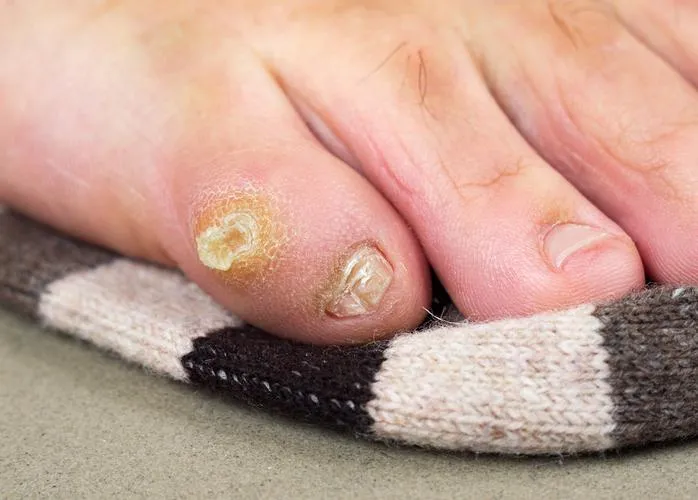
Don’t Let Corns Slow You Down: Simple Solutions for Smooth Feet!
Got painful, pesky bumps on your feet? Corns could be to blame! These small but stubborn skin growths can make every step feel uncomfortable, but don’t worry—relief is possible. In this article, we’ll dive into what causes corns, how to prevent them, and the best ways to treat them so you can walk pain-free once again.
You may be asking what is a corn? A corn is a hardened area of skin that forms due to repeated pressure or friction. The body produces this thickening to protect the underlying tissue from further damage. Corns are typically round and may appear on the tops, sides, or between toes, although they can also develop on the soles of the feet. Corns are often smaller and more defined than callouses, with a central core that can be painful.
It is important to distinguish what type of corn is presenting on the foot. There are two types of corns to be aware of. The first being hard corns. These are the most common type and often develop on the top or sides of the toes. They have a small, hard center surrounded by inflamed skin, which can be painful if pressure is applied. The second is soft corns. Soft corns form between the toes, where moisture from sweat or damp conditions softens the skin. They are typically whitish or grayish and can be very painful due to constant friction from the toes rubbing together.
So exactly what causes corns? Ill-fitting shoes, such as those that are too tight, too loose, or have high heels, can cause friction on specific areas of the feet, especially if they pinch or rub against spots on the toes or other parts of the foot. Conditions like hammertoes or bunions, which affect foot structure, can also lead to uneven pressure distribution, making certain areas more vulnerable to friction and the formation of corns. Additionally, repetitive pressure from activities like running, hiking, manual labor, or standing for extended periods can increase the likelihood of developing corns. Foot deformities, such as bunions or hammertoes, can exacerbate this problem by forcing specific areas of the foot to constantly rub against shoes, further contributing to corn formation.
Would you like to prevent corns? Preventing corns involves reducing the friction and pressure that contribute to their formation. One of the most important steps is wearing properly fitting shoes that provide the right size, adequate support, and comfort, while avoiding those that pinch or rub against the feet, especially in the toe area. Using protective padding, such as gel or foam pads, can help cushion prone areas and reduce friction. Opting for soft, breathable socks made from materials like cotton or moisture-wicking fabrics can also minimize friction between the feet and shoes. Additionally, if you have foot deformities like hammertoes or bunions, it's advisable to consult a podiatrist, who may recommend custom orthotics or specific footwear to alleviate pressure on these areas.
If you already have corns, the good news is they can be treated effectively with a few simple steps. Start by soaking your feet in warm, soapy water for 10-15 minutes to soften the skin, making it easier to remove the corn. After soaking, gently exfoliate the corn using a pumice stone or foot file, being careful not to overdo it or use sharp objects, as this could lead to injury or infection. Over-the-counter corn removers containing salicylic acid can also help break down the hardened skin, but it’s important to follow the product instructions carefully and avoid using them on broken or irritated skin. Regularly moisturizing your feet with a rich foot cream or lotion can help prevent corns from forming by keeping the skin soft and elastic. If corns become painful, infected, or don’t improve with at-home treatments, it’s best to consult a podiatrist, who can safely remove the corn and address any underlying issues, such as foot deformities.
Now you know, corns are a common foot problem that can be caused by friction and pressure from ill-fitting shoes or foot deformities. While they can be painful and bothersome, they are preventable with proper footwear, padding, and foot care. If corns do develop, gentle exfoliation, moisturizing, and over-the-counter treatments can help manage them. If you're dealing with persistent or painful corns, don’t hesitate to seek professional care from a podiatrist. With the right approach, you can keep your feet healthy, comfortable, and corn-free.